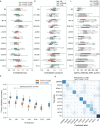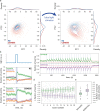Megapixel camera arrays enable high-resolution animal tracking in multiwell plates
- PMID: 35322206
- PMCID: PMC8943053
- DOI: 10.1038/s42003-022-03206-1
Megapixel camera arrays enable high-resolution animal tracking in multiwell plates
Abstract
Tracking small laboratory animals such as flies, fish, and worms is used for phenotyping in neuroscience, genetics, disease modelling, and drug discovery. An imaging system with sufficient throughput and spatiotemporal resolution would be capable of imaging a large number of animals, estimating their pose, and quantifying detailed behavioural differences at a scale where hundreds of treatments could be tested simultaneously. Here we report an array of six 12-megapixel cameras that record all the wells of a 96-well plate with sufficient resolution to estimate the pose of C. elegans worms and to extract high-dimensional phenotypic fingerprints. We use the system to study behavioural variability across wild isolates, the sensitisation of worms to repeated blue light stimulation, the phenotypes of worm disease models, and worms' behavioural responses to drug treatment. Because the system is compatible with standard multiwell plates, it makes computational ethological approaches accessible in existing high-throughput pipelines.
© 2022. The Author(s).
Conflict of interest statement
The authors declare the following competing interests: MH and JRS are employees/owners of LoopBio. All other authors declare no competing interests.
Figures





Similar articles
-
Automatically tracking feeding behavior in populations of foraging C. elegans.Elife. 2022 Sep 9;11:e77252. doi: 10.7554/eLife.77252. Elife. 2022. PMID: 36083280 Free PMC article.
-
Erratum: High-Throughput Identification of Resistance to Pseudomonas syringae pv. Tomato in Tomato using Seedling Flood Assay.J Vis Exp. 2023 Oct 18;(200). doi: 10.3791/6576. J Vis Exp. 2023. PMID: 37851522
-
High-throughput tracking enables systematic phenotyping and drug repurposing in C. elegans disease models.Elife. 2025 Jan 8;12:RP92491. doi: 10.7554/eLife.92491. Elife. 2025. PMID: 39773880 Free PMC article.
-
Digging deeper: methodologies for high-content phenotyping in Caenorhabditis elegans.Lab Anim (NY). 2019 Jul;48(7):207-216. doi: 10.1038/s41684-019-0326-6. Epub 2019 Jun 19. Lab Anim (NY). 2019. PMID: 31217565 Free PMC article. Review.
-
Visualizing and quantifying molecular and cellular processes in Caenorhabditis elegans using light microscopy.Genetics. 2022 Jul 30;221(4):iyac068. doi: 10.1093/genetics/iyac068. Genetics. 2022. PMID: 35766819 Free PMC article. Review.
Cited by
-
Recording dynamic facial micro-expressions with a multi-focus camera array.Biomed Opt Express. 2025 Jan 17;16(2):617-627. doi: 10.1364/BOE.547944. eCollection 2025 Feb 1. Biomed Opt Express. 2025. PMID: 39958861 Free PMC article.
-
Precise Quantification of Behavioral Individuality From 80 Million Decisions Across 183,000 Flies.Front Behav Neurosci. 2022 May 26;16:836626. doi: 10.3389/fnbeh.2022.836626. eCollection 2022. Front Behav Neurosci. 2022. PMID: 35692381 Free PMC article.
-
RTN2 deficiency results in an autosomal recessive distal motor neuropathy with lower limb spasticity.Brain. 2024 Jul 5;147(7):2334-2343. doi: 10.1093/brain/awae091. Brain. 2024. PMID: 38527963 Free PMC article.
-
WormSwin: Instance segmentation of C. elegans using vision transformer.Sci Rep. 2023 Jul 7;13(1):11021. doi: 10.1038/s41598-023-38213-7. Sci Rep. 2023. PMID: 37419938 Free PMC article.
-
The C. elegans Observatory: High-throughput exploration of behavioral aging.Front Aging. 2022 Aug 29;3:932656. doi: 10.3389/fragi.2022.932656. eCollection 2022. Front Aging. 2022. PMID: 36105851 Free PMC article.
References
-
- Gomez-Marin A, Paton JJ, Kampff AR, Costa RM, Mainen ZF. Big behavioral data: psychology, ethology and the foundations of neuroscience. Nat. Neurosci. 2014;17:1455–1462. - PubMed
-
- Anderson DJ, Perona P. Toward a Science of Computational Ethology. Neuron. 2014;84:18–31. - PubMed
-
- Brown, A. E. X. & de Bivort, B. Ethology as a physical science. Nat. Phys. 14, 653–657 (2018).
-
- Baek J-H, Cosman P, Feng Z, Silver J, Schafer WR. Using machine vision to analyze and classify Caenorhabditis elegans behavioral phenotypes quantitatively. J. Neurosci. Methods. 2002;118:9–21. - PubMed
Publication types
MeSH terms
Grants and funding
LinkOut - more resources
Full Text Sources
Other Literature Sources

